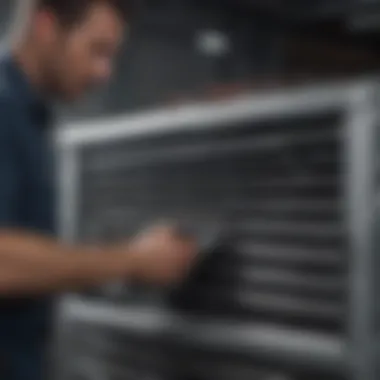Toyota Highlander Radiator Replacement Costs Explained


Intro
Replacing the radiator in a Toyota Highlander can be an overwhelming task with various factors influencing costs. Understanding these elements is crucial for car owners and enthusiasts alike. The radiator is essential for preventing engine overheating, and any malfunction can affect overall vehicle performance. In this analysis, we will explore the average costs you can expect, maintenance tips to prolong radiator life, and the implications of radiator issues on the Highlander’s durability.
Vehicle Purchasing Behavior
Factors Influencing Vehicle Purchases
When consumers are looking to purchase a vehicle like the Toyota Highlander, several factors come into play. Buyers consider features such as reliability, fuel efficiency, and maintenance costs. Many Highlander owners appreciate the vehicle's reputation for longevity, which starts with understanding the importance of maintenance, especially concerning the radiator.
Demographics of Buyers
The Highlander appeals to a diverse audience. Families often choose this model for its spacious interior and safety features, while tech-savvy individuals are drawn to its modern technology offerings. Knowing the trait of the buyer helps dealerships and manufacturers tailor services and products accordingly, including after-purchase maintenance.
Market Insights and Analysis
Consumer Behavior Analysis
Consumer behavior toward vehicle maintenance is evolving. Buyers today tend to conduct extensive research online before making a decision. This includes looking into the costs associated with potential repairs, such as radiator replacements. Many workshops and online forums provide insights into average prices, which is invaluable for the consumer.
Competitor Analysis
In the automotive market, the Highlander faces competition from models such as the Honda Pilot and Ford Explorer. Each competitor offers unique features, but the Highlander stands out in terms of reliability and resale value. As vehicle repair costs rise, factors like radiator issues can sway opinions in favor of Toyota, given its strong reputation for durability and ease of maintenance.
"The total cost of ownership extends beyond the initial purchase price; understanding future maintenance like radiator replacement is crucial for buyers."
Understanding Radiator Functionality
Understanding the functionality of a radiator in a vehicle is crucial for any Toyota Highlander owner. The radiator plays a significant role in maintaining optimal engine temperature. It does this by circulating coolant through the engine, absorbing heat, and dissipating it into the air. This process prevents the engine from overheating, which can lead to severe damage and costly repairs. When considering the costs associated with radiator replacement, knowing how it contributes to the vehicle's overall health is essential.
Role of the Radiator in Engine Cooling
The primary function of the radiator is to regulate the temperature of the engine. As the engine operates, it produces significant heat. The radiator helps manage this heat through a system of coolant. Coolant, or antifreeze, flows through the engine and absorbs heat before returning to the radiator. Once in the radiator, the coolant passes through a series of tubes and fins that allow cool air to flow over them. This airflow helps to lower the temperature of the coolant before it is cycled back to the engine.
The efficiency of this process directly affects engine performance. If the radiator fails, it can lead to elevated engine temperatures, resulting in reduced efficiency, performance loss, or complete engine failure.
Signs of Radiator Failure
Identifying signs of radiator failure can save owners from expensive repair bills. The following symptoms are key indicators that the radiator may require attention:
- Overheating: This is a common warning sign. If the engine temperature gauge frequently rises above normal levels, the radiator may not be functioning correctly.
- Coolant Leaks: Puddles of coolant beneath the vehicle or low coolant levels can indicate a leak in the radiator.
- Unusual Engine Sounds: Gurgling or hissing noises, particularly after the engine has been running, may suggest air trapped in the cooling system.
- Discoloration in Coolant: If the coolant appears rusty or contaminated, the radiator could be corroding internally, affecting its performance.
- Smoke or Steam: Seeing smoke or steam from under the hood is a clear sign of overheating, often pointing to radiator failure.
Recognizing these signs early can help prevent further damage and ensure that the vehicle maintains its performance and longevity.
Factors Influencing Replacement Costs
Replacing a radiator in a Toyota Highlander involves various considerations that directly influence the overall cost. Understanding these factors will help you make informed decisions regarding your vehicle maintenance. Key aspects such as labor costs, parts pricing, and geographical variance can significantly affect how much you end up paying for a radiator replacement. Analyzing these elements provides clarity and insight into the budgeting process, enabling Highlander owners to anticipate expenses more accurately.
Labor Costs
Labor costs account for a substantial portion of the overall replacement expense. When you take your Highlander to a professional mechanic, the fees associated with labor can vary widely based on several factors. Generally, specialized shops tend to charge higher rates than independent mechanics. This is due to their expertise and often higher overhead costs. The time required for a radiator replacement can vary, but it typically takes between two to four hours depending on the model year, engine type, and overall condition of the vehicle.
Additionally, if you are in an urban area, labor rates might be significantly higher compared to rural locations. This results in varying quotes even for the same service, highlighting the need to shop around. While attempting a do-it-yourself approach may seem cost-effective, it also requires certain skills and tools. Given the complexity of modern engines, even seemingly simple jobs can lead to costly mistakes if not performed correctly.


Parts Pricing
The cost of parts plays a crucial role in the total replacement price. Radiators come in various qualities and specifications, which impact their price points. Original Equipment Manufacturer (OEM) parts, which are made by the car's manufacturer, tend to be more expensive than aftermarket alternatives. However, OEM parts often assure compatibility and durability, which can justify their higher cost.
On the other hand, aftermarket parts may offer significant savings, but their quality can vary. It is essential to carefully evaluate the reputation of the manufacturer when selecting these options. Some popular brands that deal with aftermarket radiators include Spectra Premium, Denso, and ACDelco.
In addition to the radiator itself, consider the cost of associated components or fluids, such as coolant and hoses. These additional expenses can accumulate, thereby affecting the total cost of the project.
Geographical Variance
Geographical variance is another critical element that affects radiator replacement costs. The price of living in different regions can lead to fluctuations in labor and parts prices. In metropolitan areas, the costs are generally higher, while rural regions may provide more affordable options.
Furthermore, local demand and competition among shops can influence pricing. For example, in areas where vehicle maintenance is more competitive, you might find better deals. Meanwhile, in smaller towns with fewer mechanics, prices may not be as flexible. Additionally, environmental regulations in specific locations can impact the costs of parts and labor, particularly when it comes to disposing of old radiators.
Overall, understanding these factors can greatly improve your ability to manage the costs associated with radiator replacement. By analyzing labor charges, parts prices, and the geographical context, Highlander owners can navigate the complexities of this essential vehicle maintenance task.
Average Cost Estimates for Replacement
Understanding the average cost of replacing the radiator in a Toyota Highlander is critical for car owners. This estimate informs budget plans and helps prioritize vehicle maintenance. A well-informed decision can prevent overexpenditure and highlight options that fit financial needs. Knowing costs associated with repairs is essential for upkeeping the long-term viability of the vehicle. Timely radiator replacement can enhance performance, making it a priority for owners.
Cost Range Overview
When analyzing costs for radiator replacement, several factors must be considered. Generally, the price varies based on labor and parts. On average, the total cost may range from $600 to $1,200. This price range encompasses both the labor required and the radiator itself.
- Labor Costs: Typically, labor can amount to $100 to $150 per hour. The time needed often fluctuates between 2 to 5 hours, largely depending on the mechanic’s expertise and the vehicle's specific model.
- Parts Pricing: The price of the radiator can differ considerably. An OEM radiator may cost between $300 and $700, while aftermarket options might range from $200 to $500.
Therefore, when budgeting for a replacement, anticipate both parts and labor costs to avoid unexpected expenses during the process.
Comparative Analysis with Other Models
Comparing the costs of the Toyota Highlander radiator replacement with similar models provides valuable insight for potential buyers and car enthusiasts. For instance, vehicles such as the Honda Pilot and Ford Explorer show comparable pricing in replacement costs.
- Honda Pilot: Radiator replacement usually falls between $500 and $1,000. While similar in pricing with the Highlander, the Honda typically has higher labor costs due its design complexities.
- Ford Explorer: This model can range from $600 to $1,100, closely mirroring the Highlander both in labor and parts prices.
Understanding these comparisons allows Highlander owners to assess their vehicle in context with rivals, reflecting that the Highlander is competitive in terms of radiator replacement costs. This knowledge empowers consumers when making choices regarding vehicle purchases and anticipated maintenance expenses.
The cost of maintaining a vehicle, particularly concerning the radiator, significantly impacts overall ownership experience. Being aware of these factors leads to more informed decisions and can save both time and money.
Choosing the Right Replacement Parts
Selecting the appropriate replacement parts for the radiator is a critical aspect of maintaining the Toyota Highlander’s performance and longevity. The choice between OEM (Original Equipment Manufacturer) and aftermarket parts, as well as considerations regarding quality, can have significant ramifications for both the initial repair cost and the long-term durability of the radiator system. Choosing the wrong type or quality of part may lead to inadequate cooling, potential engine damage, and increased repair expenses in the future.
OEM vs Aftermarket Parts
When deciding on replacement parts, you typically face the choice between OEM and aftermarket components. OEM parts are manufactured by the vehicle’s original maker. They are specifically designed to meet the standards of the Highlander, ensuring compatibility and functionality. Using OEM parts can provide peace of mind because they often come with warranties that cover defects or failure.
On the other hand, aftermarket parts are made by third-party manufacturers. They may offer similar functionalities at lower prices. However, the quality can vary significantly between manufacturers. Some aftermarket components may not provide the same fit or durability as OEM parts, which means they can lead to premature failures or even damage a new radiator. Therefore, careful research is essential when considering aftermarket options.
Quality Considerations
Quality is paramount when replacing any vehicle part, especially the radiator.
Here are some key points to consider:


- Material Quality: Radiators must withstand high temperatures and pressures. Ensure that any replacement part is made from high-quality materials that can endure these conditions.
- Manufacturing Standards: Look for parts that are tested against strict quality control measures. Certifications from relevant automotive standards organizations can be a good indicator of quality.
- Brand Reputation: Consider the reputation of the brand in the market. Well-known brands often have established quality assurance processes and customer satisfaction records.
"Choosing the right parts can save you both money and hassle down the road. Investing in quality components is an investment in the overall health of your vehicle."
In summary, while it may be tempting to cut costs with cheaper options, investing in either quality OEM parts or reputable aftermarket alternatives is crucial for the Toyota Highlander’s radiator replacement. Not only does it ensure effective performance, but it also minimizes the risk of future breakdowns, ultimately safeguarding the vehicle's overall health.
Do-It-Yourself vs Professional Services
The decision between undertaking a Do-It-Yourself (DIY) radiator replacement versus hiring professional services is a central theme in understanding the overall costs and implications of radiator maintenance for the Toyota Highlander. Each option presents unique benefits and challenges that require careful consideration.
A DIY approach can appeal to individuals looking to save money on labor costs, potentially bringing the overall expense of the radiator replacement down. However, this method demands a certain level of mechanical skills and knowledge about the vehicle's systems. On the other hand, professional services can offer expertise and the convenience of ensuring the replacement is done correctly without the risk of making costly mistakes during the process.
Once you weigh these options, it becomes clear that both routes hold their own advantages, and understanding what each entails plays a crucial role in making an informed choice.
Understanding the Complexity of the Task
Replacing a radiator is not a simple task. It involves several steps, including draining the coolant, removing the old radiator, and installing the new one correctly. Additionally, there are other components that might need attention, such as hoses and clamps. Each step must be performed accurately to avoid future leaks or overheating issues.
For those with limited experience in auto repair, the intricacies of this operation can become overwhelming. Electrical connections, alignment issues, and the necessity of properly refilling and bleeding the cooling system add layers of complexity. A mistake at any of these stages can lead to further damage or safety issues with the vehicle.
Cost Comparison of DIY vs Professional Replacement
The financial aspect of choosing between DIY and professional assistance can vary significantly. Here is a basic comparison:
- DIY Replacement:
- Professional Services:
- Parts Cost: Approximately $200 to $600 depending on whether one opts for original equipment manufacturer parts or aftermarket options.
- Tools and Equipment: An additional cost if tools are not on hand, possibly another $50 to $150.
- Time Investment: Several hours, which may translate to opportunity costs in terms of missed activities or work.
- Labor Cost: Typically ranges from $100 to $200 per hour, with labor for radiator replacement averaging around 2 to 4 hours based on the shop's rate.
- Parts Cost: Often included in service fees, but aftermarket may be preferred by some shops.
- Total Cost: This may bring the total expense to between $500 and $1,500.
Therefore, if one does not have the necessary time, skills, or tools, professional services may be the more prudent choice even though it might incur a higher overall cost.
In summary, choosing between DIY replacement and hiring professionals involves balancing risk, time, expense, and one’s own capability. It is essential to weigh all factors before committing to a route.
The Importance of Regular Maintenance
Regular maintenance is not just a suggestion for vehicle owners; it is a necessity. This is particularly true for components such as the radiator in your Toyota Highlander. Maintaining the radiator ensures optimal vehicle performance and helps prevent costly repairs down the line. This section explores the significance of routine checks and fluid levels, as well as the long-term savings that can be achieved through preventive measures.
Routine Checks and Fluid Levels
Routine checks of the radiator and its fluid levels are essential. This is because the radiator plays a critical role in keeping the engine cool. If the coolant levels are low or if there is a leak, the engine could overheat, leading to potential engine damage.
Regular visual inspections can identify issues early. Look for signs of coolant leaks, corrosion, or damaged hoses. It is advisable to check the coolant level and its condition at least once a month. Proper maintenance involves not just checking levels but also ensuring that the right type of coolant is used. Using the manufacturer's recommended coolant will help maintain the radiator's efficiency.
In addition, locations of potential leaks or damages should be noted. If there is any suspicion of a leak in the cooling system, addressing it promptly can prevent more significant issues. A small investment of time each month can safeguard your vehicle's health for the long term.
Long-Term Savings through Prevention
Investing in regular maintenance can lead to substantial long-term savings. Preventive measures reduce the likelihood of unexpected breakdowns that often come with expensive repairs. When the radiator functions correctly, the entire vehicle runs more efficiently.
For instance, addressing minor issues, such as a small leak or low coolant levels, can prevent the need for a complete radiator replacement. This not only saves money but also minimizes inconveniences of severe vehicle malfunctions.
Moreover, regular checks can help maintain high fuel efficiency. An overheating engine consumes more fuel, while a well-maintained radiator contributes to better fuel economy. Moreover, ensuring that the cooling system functions properly can extend the life of the engine itself.


"An ounce of prevention is worth a pound of cure."
Impact of Radiator Issues on Overall Vehicle Performance
The radiator is a critical component in the cooling system of a Toyota Highlander. It plays a vital role in preventing the engine from overheating. When radiator issues arise, they can have significant implications not only for engine performance but also for the overall functionality of the vehicle. Hence, understanding these impacts can aid Highlander owners in making better decisions regarding maintenance and repairs.
Effects on Engine Efficiency
Engine efficiency is directly related to the cooling system's performance. A malfunctioning radiator can hinder the proper circulation of coolant throughout the engine. As a result, the engine may operate at higher temperatures than optimal, leading to reduced efficiency. An engine running hot tends to consume more fuel due to extensive combustion processes necessary to maintain power output. This inefficiency can lead to poorer fuel economy and eventually escalate operational costs for the owner.
In addition, prolonged overheating can cause critical engine components to wear prematurely, leading to further complications and expensive repairs. Car enthusiasts often emphasize the importance of maintaining optimal temperatures to ensure the longevity of both the engine and the vehicle itself. Regular checks of the radiator and associated components are essential to prevent such setbacks.
Potential Damage to Other Components
Radiator problems can extend their effects beyond just the engine. When the cooling system fails, other integral parts of the vehicle may also suffer. For instance, if the radiator leaks or clogs, it can cause the engine to overheat, leading to damage to the head gasket. Repairing a blown head gasket is significantly more costly than replacing a radiator, highlighting the value of timely interventions.
Furthermore, overheating can affect surrounding parts like the thermostat or even the transmission. A heated engine can cause fluid breakdown in the transmission, reducing its effectiveness over time. This interconnectedness implies that neglecting radiator issues can snowball into larger, more expensive problems. Keeping up with radiator maintenance not only secures the engine's health but protects vital components from further harm.
"Underestimating radiator problems can lead to extensive vehicle damage and elevated repair costs. Regular maintenance checks can prevent these scenarios."
Overall, the impact of radiator issues on vehicle performance underscores the importance of vigilance and proactive maintenance in ensuring the Toyota Highlander runs efficiently and reliably.
Warranty and Insurance Considerations
When contemplating the cost of radiator replacement in a Toyota Highlander, it is crucial to evaluate warranty and insurance considerations. These elements can significantly influence the financial implications of repair work. Understanding these factors may help owners in navigating complex repair situations and minimizing out-of-pocket expenses.
Coverage Options for Repairs
Before replacement begins, it is important to assess the coverage options. Some owners may find that their vehicle warranty includes specific provisions for radiator repairs. If the Highlander is still under warranty, the coverage could include the cost of parts and labor associated with radiator replacement. Coverage varies, so it is advisable for owners to review their warranty documents or consult with their dealer to clarify the scope of coverage.
Common warranty coverage elements include:
- Basic Warranty: General coverage often includes engine and transmission issues. Most standard warranties last three years or 36,000 miles.
- Powertrain Warranty: This typically covers major engine components and systems that impact performance, which may include the radiator.
- Extended Warranty: Some owners may opt for this, which can provide additional coverage beyond the original warranty term.
Additionally, some vehicle service contracts can cover repairs not included in the factory warranty. Exploring different options can be beneficial in reducing the overall cost burden.
Impact on Vehicle Warranty
The implications of having an impact on vehicle warranty due to radiator issues must be understood clearly. If a radiator failure is due to manufacturer defects, it should be covered under the warranty. However, if the damage results from neglect or improper maintenance, the warranty might not apply.
Furthermore, modifications made to the radiator, such as installation of aftermarket components, may void the manufacturer’s warranty. Owners must tread carefully and ensure any repairs or modifications comply with the guidelines outlined in the warranty documentation.
"Being aware of the warranty terms can save vehicle owners significant repair costs and prevent future disputes with dealerships or service providers."
It is advisable for Highlander owners to keep thorough records of maintenance and repairs. This documentation can serve as evidence when discussing warranty claims. Overall, understanding warranty and insurance considerations is vital for any Highlander owner to approach radiator replacement with informed decision-making.
The End and Final Thoughts
In assessing the cost and logistics involved in replacing a radiator in a Toyota Highlander, several critical aspects emerge. Understanding these elements not only aids in budgeting but also fosters informed decisions surrounding maintenance and repair. The radiator serves an essential function, regulating engine temperature and ensuring optimal performance. When it fails, it can lead to significant operational issues, prompting the need for swift action.
This article systematically delves into various factors impacting radiator replacement costs. Among these, labor and parts pricing stand out as prominent considerations. Recognizing the average market rates, along with geographical variances, can help a car owner gauge a fair price. Furthermore, making an educated choice between OEM and aftermarket parts involves an understanding of quality and longevity. Both options have their merits, and the right choice depends on individual priorities and budget constraints.
Recap of Key Points
Radiator replacement is not merely about finding the lowest quote; it incorporates a comprehensive view of several factors:
- Functionality of the Radiator: Essential for engine cooling.
- Cost Influencers: Labor, parts, and location play crucial roles.
- Average Costs: Understand the range typical for your area.
- Parts Selection: OEM vs. aftermarket considerations can impact long-term effectiveness.
- Future Maintenance: Regular checks help prevent costly repairs.
Regular maintenance and early detection of radiator issues can provide substantial long-term savings.
Future Considerations for Highlander Owners
As a Toyota Highlander owner, keeping abreast of your vehicle’s cooling system is vital. Consider these future points:
- Routine Inspections: Proactive checks can help catch radiator issues before they escalate.
- Educate Yourself: Understanding the engine's cooling system can empower owners to make sound decisions regarding maintenance and repair.
- Cost Planning: Always set aside a budget for non-regular maintenance; unexpected repairs can be costly.
- Choosing Qualified Technicians: Investing in skilled service providers ensures that the replacement work meets high standards, mitigating risks of future complications.















